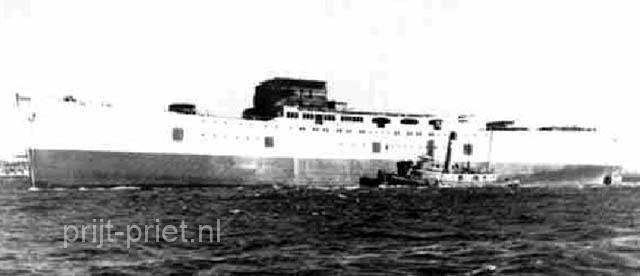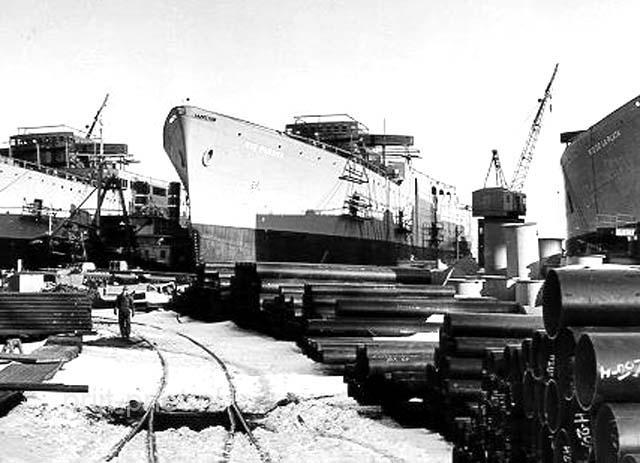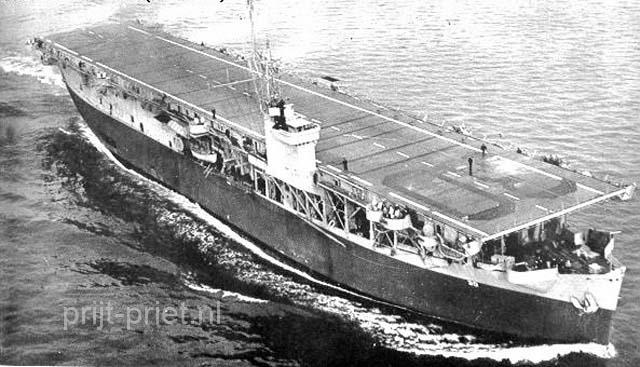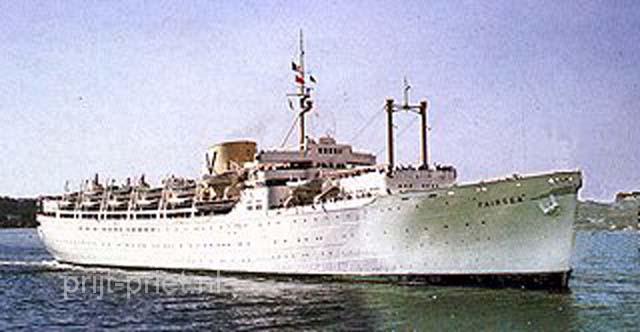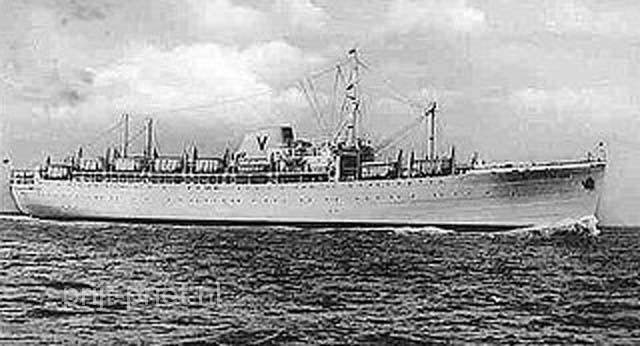The Fairsea
It sailed under the following names: Fairsea, Rio de la Plata, HMS Charger and USS Charger
Specifications
Ship Name Fairsea
Launched 01 Mar 1941
Built By Sun Shipbuilding and Drydock co, Chester, Pennsylvania (ship #188)
Tonnage 11678
Service Speed 16 Knots
Propulsion Doxford Diesels – Single Screw
Length 492 Feet 150 Metres
Width 69 Feet 21.1 Metres
Other Details 1 Funnel, 1 Mast
Converted
Fairsea was another of the converted aircraft carriers to see service in the Australian emigrant trade for many years. Although generally thought of as a Sitmar ship, Fairsea spent most of her career under the Panamanian flag, but had been built for service under the American flag as Rio de la Plata. In February 1939, and American shipping company, Moore – McCormick Line, ordered four ships, with accommodation for about 70 passengers, to operate from New York to the east coast of South America. They were to be the first American passenger vessels to be fitted with diesel machinery, in this case two 6-cylinder Doxford diesels geared to a single shaft.
Launched
Launched on 01 March 1941, Rio de la Plata was taken over by the government in October that year, and completed as an escort carrier. Handed over to the Royal Navy under the lend-lease scheme, she was commissioned as HMS Charger on 03 March 1942. Later in 1942, the vessel was returned to the Americans, and as USS Charger saw considerable service in the Pacific. USS Charger was released from naval service on 15 March 1946, and placed under the management of Moore-McCormick Line. The flight deck was removed, and the ship converted to carry troops, in which guise she saw brief service, then was laid up and offered for sale. In 1949, the vessel was bought by Alexandre Vlasov, and joined his Alvion Steam Ship Corporation as Fairsea. She was rebuilt as a passenger ship, while Vlasov obtained a contract from the IRO for her to transport displaced persons and refugees.
Accomodation
With rather austere accommodation for 1800 person, Fairsea departed Genoa on 03 December 1949, bound for Australia, reaching Sydney on 30 December 1949.Over the next three years, Fairsea voyaged regularly from Italy to Australia, but under the terms of the IRO contract, had to return to Europe empty. In February 1952, Vlasov opened an office in Sydney, and began offering passages to Italy on his ships. In April 1953, Fairsea was taken off the Australian trade, to make six round trips between Bremerhaven and Quebec, offering accommodation for 40 first class and 1400 tourist class passengers. In September 1953, Fairsea made her first departure from Bremerhaven to Australia, a route she maintained for the next two years. While berthing in Melbourne in November 1953, a fire broke out in the engine room of Fairsea, but the engineers were able to extinguish the blaze quickly, though the engine room was flooded.
Australia
When Georgic was withdrawn from service in 1955, Fairsea was chartered to carry British migrants. The first non-British ship to be allocated to this service, she left Southampton for the first time on 6 December 1955, and served in this role for the next 18 months. It was then decided to use Fairsea on a round-the-world route from Britain to Australia.
February 1957
In February 1957, Fairsea crossed the Tasman for the first time to visit New Zealand, then crossed the Pacific for her first transit on the Panama Canal. In July 1957, Fairsea made the first of three round trips from Bremerhaven to New York, then was withdrawn for six months to undergo an extensive refit. The appearance of the ship was changed considerably, in Triest, as the superstructure was raised one deck, and the forward section plated in. Internally, full air-conditioning was installed, the accommodation improved, and new public rooms added in a deckhouse forward. Emerging in April 1958, her tonnage had been increased to 13432 Gross. Fairsea offered accommodation for 1460 tourist class passengers, and she was transferred from Panamanian to Fairsea voyaged regularly between Britain and Australia, and in 1961 was given another extensive refit, during which the accommodation was further upgraded, and capacity reduced to 1212 in one class. On 7 July 1966, Fairsea departed Sydney on her first cruise, visiting Hayman Island, Brisbane and Melbourne, immediately followed by her second cruise, to Cairns, Hayman Island and Melbourne. At that time, Sitmar were not heavily involved in cruising, and Fairsea made very few such trips. In 1968, Fairsea reverted to Panamanian registry again, her registered owners being Passenger Liner Services Inc. She still operated as a unit of the Sitmar fleet but was due to be withdrawn in 1970.
On 14 January 1969, Fairsea left Sydney for New Zealand and Britain, with 986 passengers on board. On 29 January 1969, an engine room fire disabled the vessel when she was midway between Tahiti and Panama. The freighter Louise Lykes arrived on the scene and towed Fairsea to Balboa, where she arrived on 3 February 1969, with her passengers still on board. They were all flown to their destinations from Panama, while Fairsea was inspected to decide her future. Being one of a very few ships to have been fitted with Doxford geared diesels, spare parts were no longer available, and it would have been necessary to have new parts designed and manufactured to repair the damage. This was considered to be uneconomic, so she was sold to shipbreakers in Italy. On 9 July 1969, Fairsea left Panama under tow of the tug Vortice, arriving on 6 August 1969 at La Spezia.
